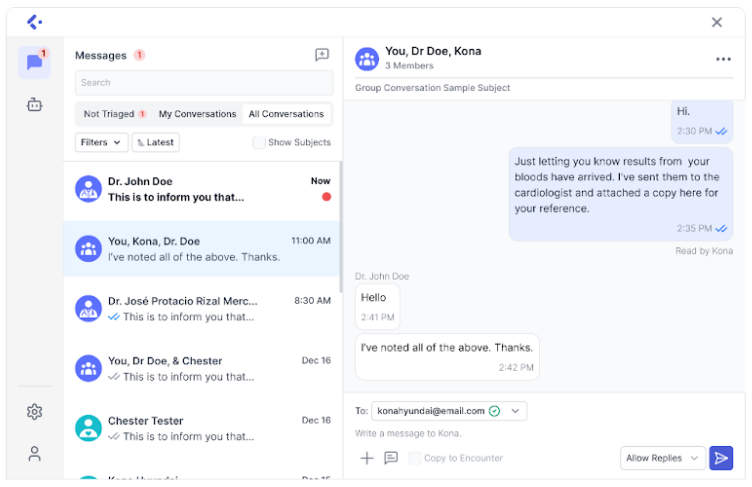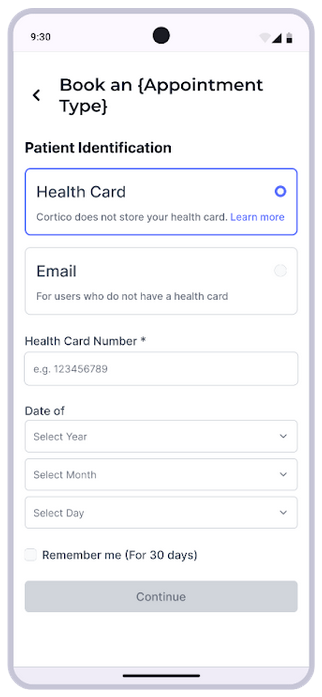
Author’s note:* This article shares the Cortico team’s experiences from deploying healthcare workflow automation for thousands of providers. My aim is to provide practical insights about the impact and outcomes of clinical workflow automation, to help inform practices during their digital transformation efforts. The included case studies are real clinics whose identity is restricted for privacy reasons. We have their permission to offer reference calls upon request, so if you wish to speak to them, just contact us!
What is Healthcare Workflow Automation?
Healthcare workflow automation involves the use of technology to delegate and streamline tasks related to care delivery that do not need to be completed by a human clinician or staff member.
Workflow automation in healthcare is most commonly utilized for administrative and operational tasks (such as allowing patients to self-schedule appointments or obtain test results online). However, in some circumstances, a machine, robot, or software program may also assist with or deliver direct clinical care.
When well-designed automation products are deployed with adequate clinical oversight, everyone in the healthcare ecosystem benefits. Clinicians enjoy reduced administrative burden, giving them more time to focus on care delivery. Patients have greater access to care and a more streamlined overall experience. And administrators can operate their practices more efficiently.
The Origins of Healthcare Workflow Automation
Doctors, practice owners, and managers often grapple with a common challenge: the substantial cost of administrative burden.
The Impact of Excessive Administrative Burden
Studies show that physicians in the US spend nearly two hours on EMR tasks per hour of direct care, with administrative expenses accounting for 15% to 25% of total national health expenditures.
Canada is in a similar situation, with 18.5 million physician hours wasted each year on unnecessary administrative tasks.
Excessive administrative burden has long been identified as a key driving factor behind the physician burnout and health workforce challenges in both countries, spurring significant interest in strategies to automate healthcare provider workflows.
Digital Workflow Automation for Healthcare
Historically, healthcare providers have sought various digital or tech-enabled solutions to address excessive administrative burden.
Early approaches to automate healthcare workflows included:
-
Remote medical assistants - Offsite medical scribes and scheduling assistants have been experimented with by health services for many years. In most cases, efficiency gains are largely offset by the complexities involved in working with an external provider.
-
EMR advancements - It has long been promised that advancements in electronic medical records platforms would significantly reduce administrative burden. Unfortunately, in many cases the use of EMRs have actually increased administrative burden, rather than minimized it.
-
Patient engagement platforms - Preliminary iterations of patient engagement platforms delivered innovative features, such as self-scheduling solutions and automated reminders. However, in clinic settings, they failed to deliver meaningful efficiency gains and achieve a provider-to-staff ratio better than 1:1 (eg, one support staff member employed per physician).
A Shift to Value-Based Digital Solutions
Shortcomings in the first generation of healthcare workflow automation solutions emphasized the importance of viewing technology advancements through a value-based lens.
In short, approaches to automate healthcare workflows should achieve a measurable business impact for healthcare providers and deliver real-world return on investment, rather than simply utilizing technology for its own sake.
At Cortico, we’ve adopted the following definition to ensure our solutions to automate healthcare workflows deliver real, measurable results:
Healthcare Workflow Automation Definition: Technology that is accountable to, and evaluated on, real-world business outcomes that result from its implementation of clinical workflows.
Value-Based Technology, Deep Integrations, and AI Agents
Cortico is part of a new generation of healthcare workflow automation tools, which are quantitatively different in that they surpass old systems and obtain a favourable provider-to-staff ratio (often reaching as high as 4:1 and beyond).
Fundamentally, Cortico’s healthcare automation solutions act as a digital medical assistant, designed to demonstrate measurable workflow efficiency improvements.
A variety of factors combine to achieve this:
-
Deep integration with EMRs, using technology such as APIs, robotic process automation (RPA), browser extensions, as well as contextual and Smart on FHIR launch.
-
AI agents to manage the nuanced aspects of clinical workflows that are challenging for traditional software solutions to assist with.
-
Intuitive patient engagement tools that allow patients to independently complete tasks that historically consumed healthcare resources, such as appointment scheduling and completing intake forms.

Cortico automates healthcare workflows with seamless patient self-scheduling
Addressing the shortfalls of earlier systems and delivering real positive financial impact during a time of significant market pressure has enabled Cortico to become one of the leading healthcare workflow automation software companies.
Outcomes from Workflow Automation in Healthcare
Below are summaries from case studies demonstrating the growth in capacity and provider count that clinics have achieved using Cortico, without the need to add a large admin staff. We’re proud of what all our customers have achieved, but here are four examples to illustrate this trend:
Clinic 1 - Virtual Walk-In
Grew to 14 doctors, with only 2 admin staff—100% growth in revenue 12 months.
“Cortico’s software is a game-changer for our telehealth practice. It streamlines daily operations, effortlessly managing over 200 daily bookings with reliable automation. This allows us to prioritize patient care.”
Clinic 2 - Hybrid Specialist and GP Clinic
Increased to 12 doctors with only 2 admin staff—200% growth in 12 months.
“Cortico reduces admin work for our clinic, helping us to avoid hiring more staff! Thank you Cortico”
Clinic 3 - Hybrid Pedatric and GP Clinic
Increased from 12 to 22 doctors, operating efficiently with 6 admin staff—80% growth in 18 months.
“A lot of other clinics are closing down due to overhead costs, while we’re growing thanks to Cortico.”
Clinic 4 - Family Practice
200+ MD hours reclaimed by saving 18 to 29 admin hours each week—$20k+ recovered annually.
“As a busy physician, Cortico has been a game changer - streamlining admin tasks so I can focus on what matters most: my patients”
Staff Empowerment with Workflow Automation in Healthcare
Five years of dedicated research and development at Cortico have shown that up to 84% of medical admin work can be automated.
The tasks often automated are those frequently cited as most burdensome—repetitive data entry and extensive phone duties—which collectively account for a significant portion of administrative effort.
It’s notable that even with these efficiency gains, a reduction in staff headcount isn’t always a common or primary outcome. Instead, we frequently observe practices experiencing accelerated growth after adopting Cortico’s healthcare workflow automation solutions.
Achieving Growth Via Automation
With the newfound efficiency, Cortico customers can allocate their admin staff to higher-value “physician assist” tasks and helping vulnerable patients who need extra care. In turn, this contributes to another outcome - an average improvement provider capacity and output by approximately 15%. (This result also comes from direct automation of clinical admin work previously done by the clinician, and a reduction in no-shows)
Activity gains are obtained primarily by reducing no-shows and automating select clinician admin tasks, such as follow-ups, providing documents to patients, and manually delegating tasks to support staff.
This dynamic allows a given size of administrative staff to support a considerably larger number of providers. It also enables team members to focus on higher-value, more engaging work, while simultaneously enhancing output per provider.
Collectively, the impact of Cortico’s healthcare workflow automation solutions can significantly improve a practice’s competitiveness. This helps clinics that might have previously faced financial viability challenges evolve into thriving, efficient businesses, with promising opportunities for their owners.

Doctors can securely send documents with Cortico via SMS or email
Potential Challenges of Healthcare Workflow Automation
The net impact of thoughtfully implemented workflow automation in healthcare is positive. However, clinicians, administrators, and clinic owners should be aware of several potential challenges and pitfalls.
Job Market Impacts
A direct reduction in headcount isn’t always an outcome of automating healthcare workflows, but it must be noted that effective implementation generally reduces future administrative hiring needs dramatically.
Ultimately, outcomes in this area depend on how the management team decides to allocate the newfound capacity.
As stated previously, our experience is that most practices retain their current support staff while increasing clinical headcount and activity. However, there’s no getting around the fact that workflow automation for healthcare does reduce the total number of medical admin jobs.
Marginalization of Traditional Clinics
Many practices have not yet implemented clinical workflow automation, and hence risk losing financial viability compared to their peers.
For some providers, the idea of automation can be intimidating and is not always readily embraced. Unfortunately, under current market conditions, this marginalizes their ability to operate competitively in the new digital-first landscape.
A useful re-frame for healthcare providers reluctant to adopt clinical workflow automation is to consider the change from the patient’s experience.
Of course, patients want to be treated by a human clinician. But we know that today’s healthcare consumers expect a streamlined, digital-first experience that provides prompt access to care. The modern healthcare consumer is willing to change providers to access a more convenient care experience, challenging the narrative that patients value continuity of care from the same physician or clinic above all else.
Does Practice Automation Work for Elderly Patients?
Yes! Contrary to what intuition may suggest, we’ve observed the following from implementing Cortico among clinics primarily serving elderly patients:
-
Elderly patients often have caregivers who coordinate their care and save time using Cortico. This results in reduced carer stress and improved access to care.
-
Many elderly patients successfully use the platform on a regular basis. Approaches like avoiding the need to install an app (we predominantly use web-based experiences requiring fewer clicks) have made the technology very accessible across generations.
-
Clinic staff are free to focus more on vulnerable and elderly patients who need extra support, since 90% or more of the other patients prefer to interact digitally.
"I love what Cortico is doing for us, and I am still confused why a lot more clinics have not moved towards this level of automation. I have a 97 yr patient able to book through Cortico with me regularly”
Dr. Jagdeep Sandhu, Curtis Health
Return on Investment of Healthcare Workflow Automation
Here’s a guide to calculating a preliminary return on investment (ROI) from Cortico’s healthcare workflow automation solutions.
How to Calculate ROI from Workflow Automation
-
Calculate the increased profit based on a 15% activity increase from providers. Add an admin cost reduction of 50% to 84%, depending on the automations chosen.
-
Factor in the platform costs. This amounts to $82 to $199 per full-time provider. It’s good to factor in at least 1 hour per month of manager time to administer the platform, especially in the first quarter.
-
Estimate the ROI. In most cases, the figure should be in the 800% range.
-
Test the solution and verify that the associated ROI is obtained.
Cortico’s ROI Guarantee
Cortico offers a 90-day money-back guarantee on the outcomes described above.
While exact results vary, if Cortico fails to obtain an acceptable ROI, all fees from this 90-day period are refunded.
A monthly business review and real-time dashboard are provided to monitor outcomes, such as identifying the number of appointments booked in Cortico.
Adoption rates by patients for our healthcare workflow automation solutions are typically in the high double digits.
Healthcare Workflow Automation: Final Thoughts
Providers in the US, Canada, and beyond are struggling under the weight of unprecedented rates of physician burnout, workforce shortages, and escalating costs.
Excessive administrative burden—which has only increased with the advent of modern EMR systems—is a key driver of these challenges.
We can’t do away with the current EMR-led approach to clinical practice. However, with intelligent healthcare workflow automation solutions, it’s possible to significantly reduce administrative burden to produce better outcomes for patients and providers.
In this article, we’ve provided concrete examples of how Cortico’s suite of healthcare workflow automation products can rapidly generate a variety of benefits for clinics and providers of various backgrounds.
If you’re already using Cortico, thanks again for being on this journey of automation with us!
To discover how Cortico could transform your practice, please drop us a line or book a demo with the button below.








